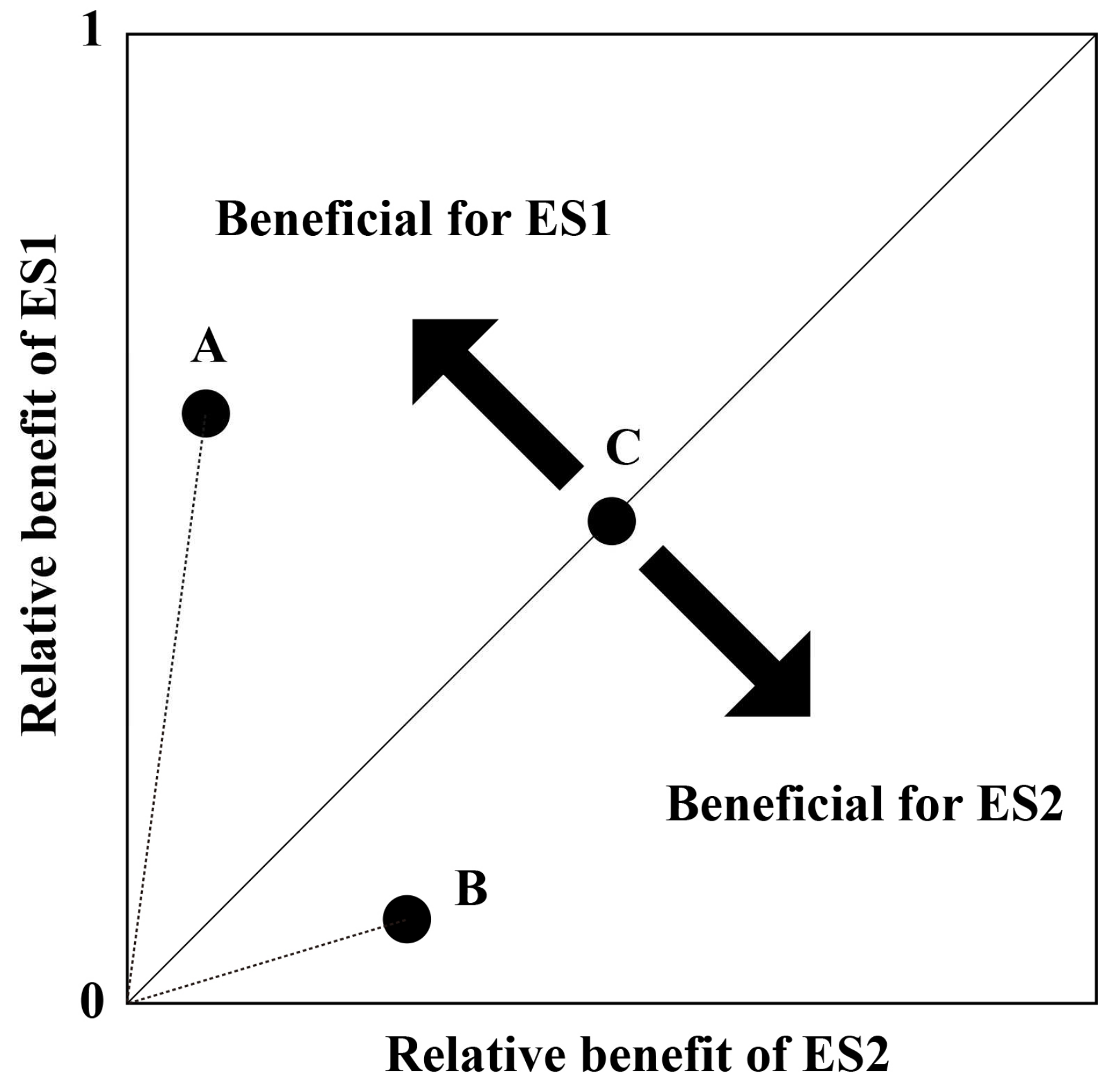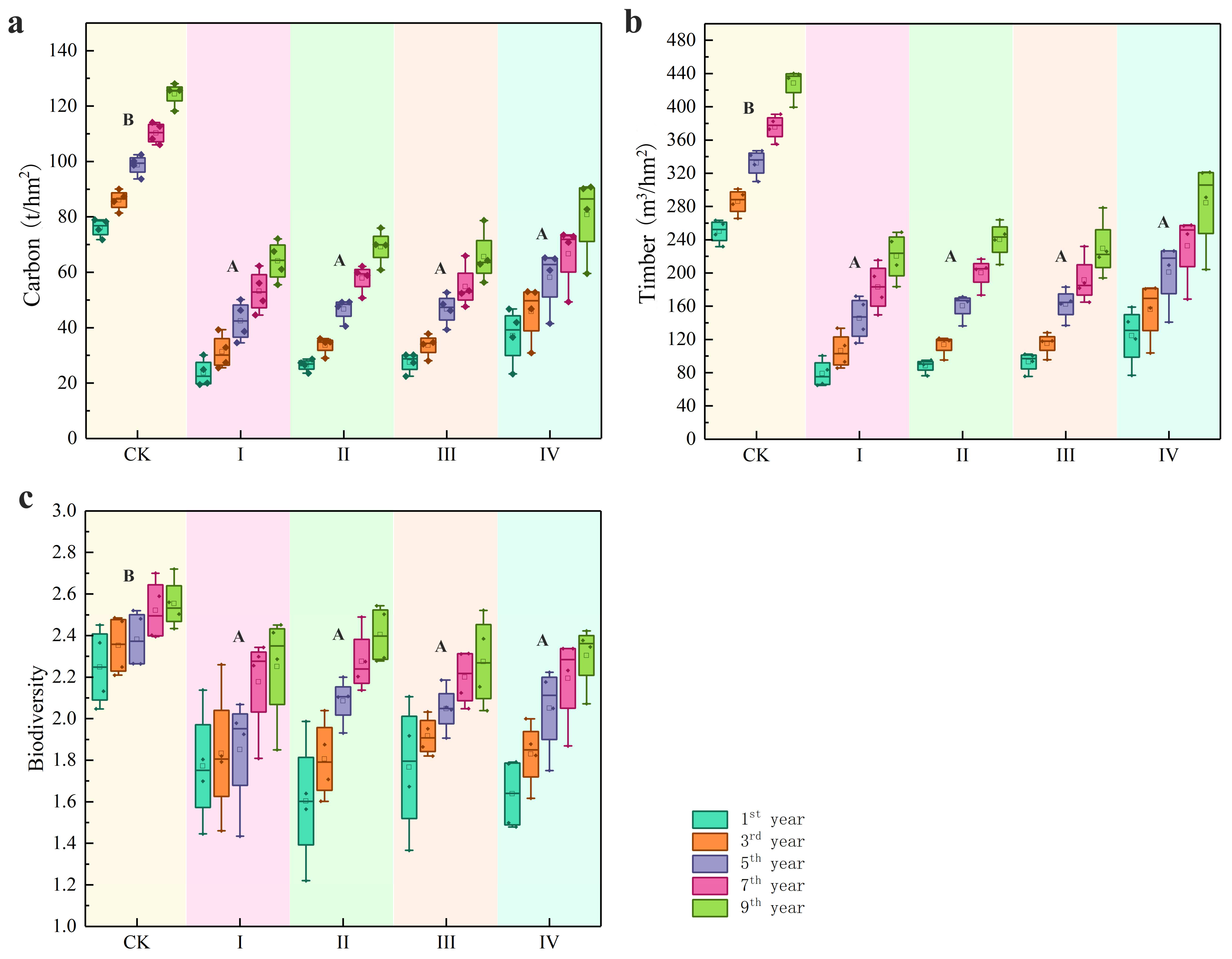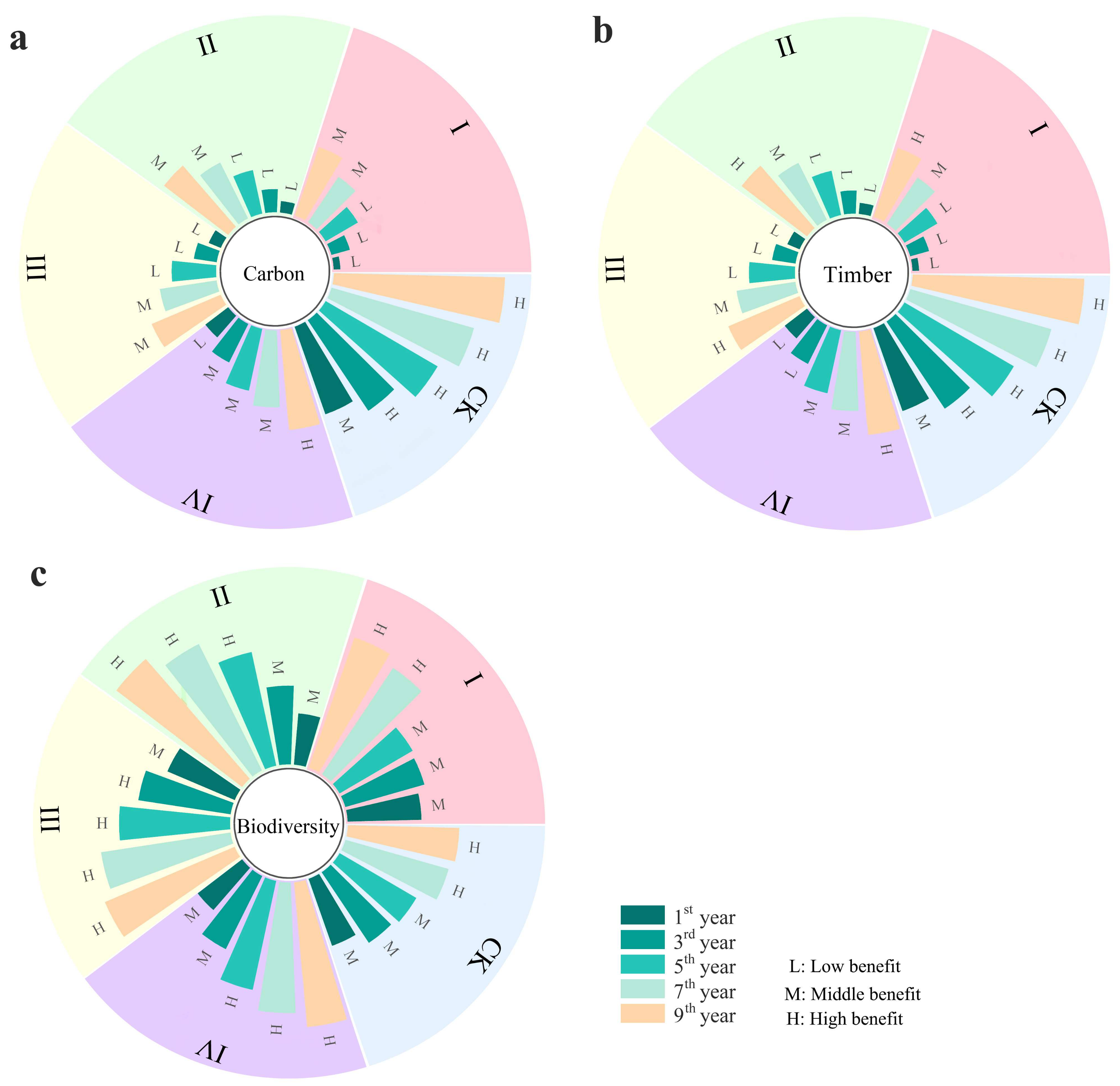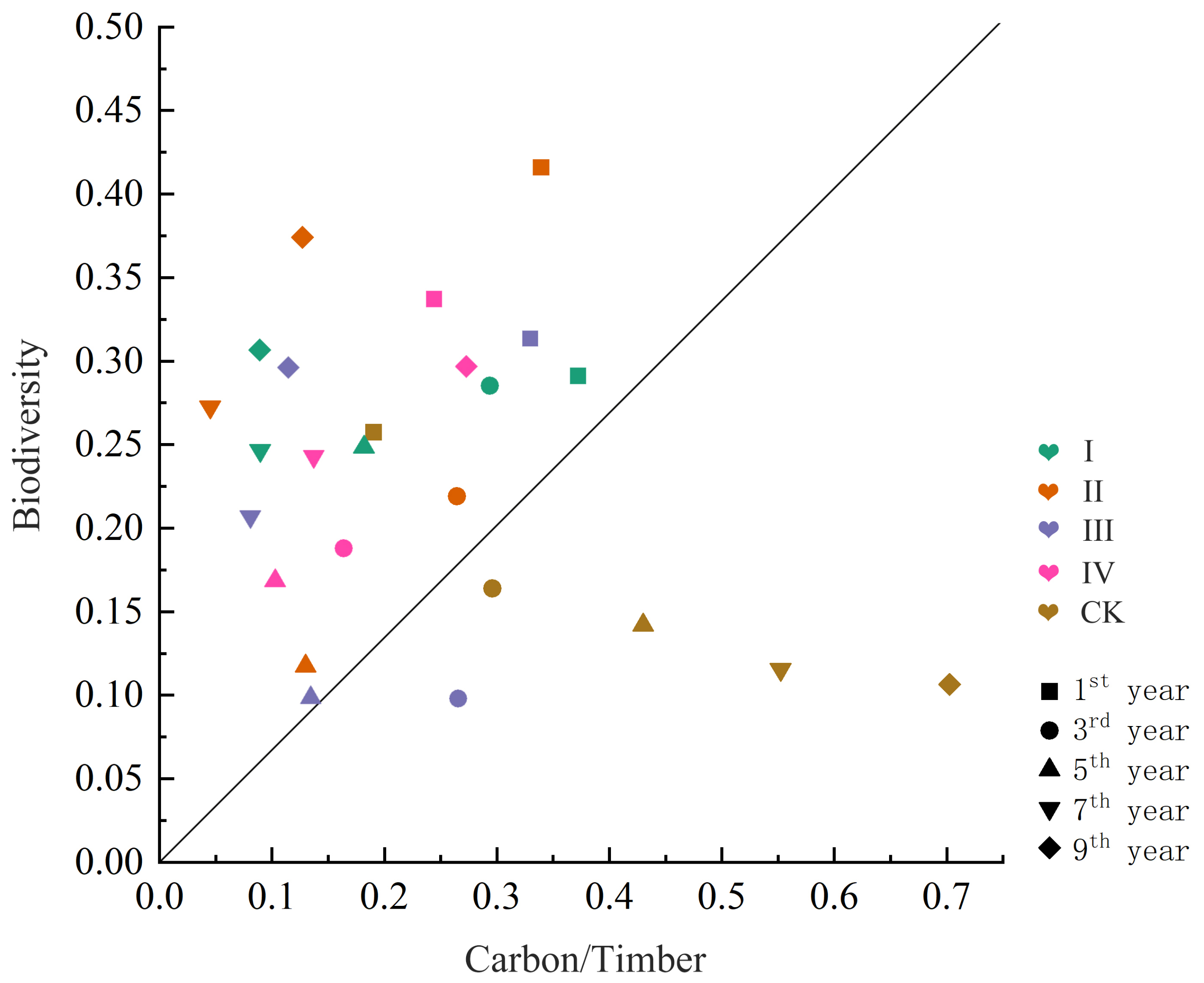Impact of Management Measures on Multiple Ecosystem Function Trade-Offs and Their Dynamics in Subtropic Pinus massoniana Plantations
Abstract
:1. Introduction
2. Materials and Methods
2.1. Overview of the Study Area
2.2. Sampling Design
2.3. Data Survey
2.4. Quantification of Ecosystem Functions
2.4.1. Timber Production
2.4.2. Carbon Sequestration
2.4.3. Biodiversity
2.5. Quantification of Integrated Functional Indices and Ecosystem Function Interactions
2.6. Data Analysis
3. Results
3.1. Quantitative Analysis of Ecosystem Functions with Different Operational Measures
3.2. Relative Benefits of Ecosystem Functions
3.3. Differences in Composite Functional Indices of Different Operational Measures
3.4. Trade-Offs between Ecosystem Functions
4. Discussion
4.1. Impacts of Different Management Measures on Ecosystem Functions
4.2. Impacts of Different Management Measures on Relative Ecosystem Benefits and Integrated Functions
4.3. Ecosystem Trade-Offs under Different Management Measures and Their Dynamics
4.4. Limitations of This Study and Directions for Further Development
5. Conclusions
Author Contributions
Funding
Data Availability Statement
Conflicts of Interest
References
- Brack, C.; Mcelhinny, C.; Waterworth, R.; Roberts, S. Multi-scale Forest Inventory and Modelling for Multi-purpose Management (Multipurpose Forest Management). J. For. Plan. 2011, 16, 133–139. [Google Scholar] [CrossRef]
- Wu, J. Landscape sustainability science: Ecosystem services and human well-being in changing landscapes. Landsc. Ecol. 2013, 6, 999–1023. [Google Scholar] [CrossRef]
- Kubiszewski, I.; Costanza, R.; Anderson, S.; Sutton, P. The future value of ecosystem services: Global scenarios and national implications. Ecosyst. Serv. 2017, 26, 289–301. [Google Scholar] [CrossRef]
- Brauman, A.K.; Daily, C.G.; Duarte, K.T.; Mooney, H.A. The Nature and Value of Ecosystem Services: An Overview Highlighting Hydrologic Services. Annu. Rev. Environ. Resour. 2007, 32, 67–98. [Google Scholar] [CrossRef]
- Wu, S.; Li, S. Ecosystem service relationships: Formation and recommended approaches from a systematic review. Ecol. Indic. 2019, 99, 1–11. [Google Scholar] [CrossRef]
- Howe, C.; Suich, H.; Vira, B.; Mace, G.M. Creating win-wins from trade-offs? Ecosystem services for human well-being: A meta-analysis of ecosystem service trade-offs and synergies in the real world. Glob. Environ. Chang. 2014, 28, 263–275. [Google Scholar] [CrossRef]
- Cord, A.F.; Bartkowski, B.; Beckmann, M.; Dittrich, A.; Hermans-Neumann, K.; Kaim, A.; Lienhoop, N.; Locher-Krause, K.; Priess, J.; Schröter-Schlaack, C.; et al. Towards systematic analyses of ecosystem service trade-offs and synergies: Main concepts, methods and the road ahead. Ecosyst. Serv. 2017, 28, 264–272. [Google Scholar] [CrossRef]
- Haase, D.; Schwarz, N.; Strohbach, M.; Kroll, F.; Seppelt, R. Synergies, Trade-offs, and Losses of Ecosystem Services in Urban Regions: An Integrated Multiscale Framework Applied to the Leipzig-Halle Region, Germany. Ecol. Soc. 2012, 3, 22. [Google Scholar] [CrossRef]
- Mengist, W.; Soromessa, T.; Legese, G. Ecosystem Services Research in Mountainous Regions: A Systematic Literature Review on Current Knowledge and Research Gaps. Sci. Total Environ. 2019, 702, 134581. [Google Scholar] [CrossRef] [PubMed]
- Crouzat, E.; Mouchet, M.; Turkelboom, F.; Byczek, C.; Meersmans, J.; Berger, F.; Verkerk, P.J.; Lavorel, S. Assessing bundles of ecosystem services from regional to landscape scale: Insights from the French Alps. J. Appl. Ecol. 2015, 52, 1145–1155. [Google Scholar] [CrossRef]
- Schroder, S.A.; Tóth, S.F.; Deal, R.L.; Ettl, G.J. Multi-objective optimization to evaluate tradeoffs among forest ecosystem services following fire hazard reduction in the Deschutes National Forest, USA. Ecosyst. Serv. 2016, 22, 328–347. [Google Scholar] [CrossRef]
- Pang, X.; Nordström, E.M.; Böttcher, H.; Trubins, R.; Mörtberg, U. Trade-offs and synergies among ecosystem services under different forest management scenarios—The LEcA tool. Ecosyst. Serv. 2017, 28, 67–79. [Google Scholar] [CrossRef]
- Zhou, X.; Zhu, H.; Wen, Y.; Goodale, U.M.; Li, X.; You, Y.; Ye, D.; Liang, H. Effects of understory management on trade-offs and synergies between biomass carbon stock, plant diversity and timber production in eucalyptus plantations. For. Ecol. Manag. 2017, 410, 164–173. [Google Scholar] [CrossRef]
- Timilsina, N.; Heinen, J. Forest Structure Under Different Management Regimes in the Western Lowlands of Nepal. J. Sustain. For. 2008, 26, 112–131. [Google Scholar] [CrossRef]
- Zhang, B.; Dong, X.; Qu, H.; Gao, R.; Mao, L. Effects of thinning on ecosystem carbon storage and tree-shrub-herb diversity of a low-quality secondary forest in NE China. J. For. Res. 2022, 4, 977–991. [Google Scholar] [CrossRef]
- Li, J.; Hao, M.; Fan, C.; Zhang, C.; Zhao, X. Effect of tree species and functional diversity on ecosystem multifunctionality in temperate forests of northeast China. Chin. J. Plant Ecol. 2023, 47, 1507–1522. (In Chinese) [Google Scholar] [CrossRef]
- Larsen, J.B.; Nielsen, A.B. Nature-based forest management—Where are we going? For. Ecol. Manag. 2007, 238, 107–117. [Google Scholar] [CrossRef]
- Xie, Y.; Lu, Y.; Lei, X.; Liu, X. Benefit evaluation and enlightenment of implementation of long-term ecological planning of forestry development in Lower Saxony, Germany. World For. Res. 2021, 34, 98–102. (In Chinese) [Google Scholar] [CrossRef]
- Wang, Q.; Wang, S.; Xu, G.; Fan, B. Conversion of secondary broadleaved forest into Chinese fir plantation alters litter production and potential nutrient returns. Plant Ecol. 2010, 2092, 269–278. [Google Scholar] [CrossRef]
- Wang, Q.; Wang, W.; Lin, S.; Cao, Z.; Chen, Q.; He, K. Stand structure adjustment based on the near-natural management of plantation ecological public forests in eastern Qinghai. Acta Ecol. Sin. 2021, 41, 5004–5015. (In Chinese) [Google Scholar] [CrossRef]
- Pommerening, A.; Murphy, S.T. A review of the history, definitions and methods of continuous cover forestry with special attention to afforestation and restocking. Forestry 2004, 77, 27–44. [Google Scholar] [CrossRef]
- Cohen, J.E.; Newman, C.M. When will a large complex system be stable? J. Theor. Biol. 1985, 113, 153–156. [Google Scholar] [CrossRef]
- Cronkleton, P.; Bray, D.B.; Medina, G. Community Forest Management and the Emergence of Multi-Scale Governance Institutions: Lessons for REDD+ Development from Mexico, Brazil and Bolivia. Forests 2011, 2, 451–473. [Google Scholar] [CrossRef]
- Suarez-Rubio, M.; Wilson, S.; Leimgruber, P.; Lookingbill, T. Threshold Responses of Forest Birds to Landscape Changes around Exurban Development. PLoS ONE 2013, 8, e67593. [Google Scholar] [CrossRef]
- Svob, S.; Arroyo-Mora, J.P.; Kalacska, M. The development of a forestry geodatabase for natural forest management plans in Costa Rica. For. Ecol. Manag. 2014, 327, 240–250. [Google Scholar] [CrossRef]
- Noguchi, M.; Miyamoto, K.; Okuda, S.; Itou, T.; Sakai, A. Heavy thinning in hinoki plantations in Shikoku (southwestern Japan) has limited effects on recruitment of seedlings of other tree species. J. For. Res. 2016, 21, 131–142. [Google Scholar] [CrossRef]
- Jactel, H.; Bauhus, J.; Boberg, J.; Bonal, D.; Castagneyrol, B.; Gardiner, B.; Gonzalez-Olabarria, J.R.; Koricheva, J.; Meurisse, N.; Brockerhoff, E.G. Tree Diversity Drives Forest Stand Resistance to Natural Disturbances. Curr. For. Rep. 2017, 3, 223–243. [Google Scholar] [CrossRef]
- Wang, C.; Wang, S.; Fu, B.L.Y.; Liu, Y.; Wu, X. Integrating vegetation suitability in sustainable revegetation for the Loess Plateau, China. Sci. Total Environ. 2020, 759, 143572. [Google Scholar] [CrossRef] [PubMed]
- Gauthier, S.; Bernier, P.; Kuuluvainen, T.; Shvidenko, A.Z.; Schepaschenko, D.G. Boreal forest health and global change. Science 2015, 349, 819–822. [Google Scholar] [CrossRef] [PubMed]
- Lewis, S.L.; Wheeler, C.E.; Mitchard, E.T.A.; Koch, A. Restoring natural forests is the best way to remove atmospheric carbon. Nature 2019, 568, 25–28. [Google Scholar] [CrossRef] [PubMed]
- Roopsind, A.; Caughlin, T.T.; van der Hout, P.; Arets, E.; Putz, F.E. Trade-offs between carbon stocks and timber recovery in tropical forests are mediated by logging intensity. Glob. Chang. Biol. 2018, 24, 2862–2874. [Google Scholar] [CrossRef] [PubMed]
- Hoque, M.Z.; Cui, S.; Islam, I.; Xu, L.; Ding, S. Dynamics of plantation forest development and ecosystem carbon storage change in coastal Bangladesh. Ecol. Indic. 2021, 130, 107954. [Google Scholar] [CrossRef]
- Wu, W.; Xiang, W.; Gou, M.; Xu, C.; Ouyang, S.; Fang, X. Trade-off and synergy between ecosystem services in three secondary forests in the mid-subtropical area of Southern China. J. For. Environ. 2019, 39, 256–264. (In Chinese) [Google Scholar] [CrossRef]
- Yu, Z.; Liu, S.; Wang, J.; Wei, X.; Schuler, J.; Sun, P.; Harper, R.; Zegre, N. Natural forests exhibit higher carbon sequestration and lower water consumption than planted forests in China. Glob. Chang. Biol. 2018, 25, 68–77. [Google Scholar] [CrossRef] [PubMed]
- Li, H.; Lei, Y. Estimation and Evaluation of Forest Biomass Carbon Storage in China, 1st ed.; China Forestry Publishing House: Beijing, China, 2010. (In Chinese) [Google Scholar]
- Lei, X.; Wang, W.; Peng, C. Relationships between stand growth and structural diversity in spruce-dominated forests in New Brunswick, Canada. Can. J. For. Res. 2009, 39, 1835–1847. [Google Scholar] [CrossRef]
- Bradford, J.B.; D’Amato, A.W. Recognizing trade-offs in multi-objective land management. Front. Ecol. Environ. 2012, 10, 210–216. [Google Scholar] [CrossRef]
- Duan, B.; Feng, Q.; Yuan, Y.; Li, P. Ecosystem services trade-offs and synergies in Qianjiangyuan National Park system pilot. Tour. Sci. 2021, 35, 11–31. [Google Scholar] [CrossRef]
- Sheng, W. On the maintenance of long-term productivity of plantation in China. For. Res. 2018, 31, 1–14. (In Chinese) [Google Scholar] [CrossRef]
- Deng, X.; Zhao, Y.; Wu, F.; Lin, Y.; Lu, Q.; Dai, J. Analysis of the trade-off between economic growth and the reduction of nitrogen and phosphorus emissions in the Poyang Lake Watershed, China. Ecol. Model. 2011, 222, 330–336. [Google Scholar] [CrossRef]
- Feng, G.; Ai, X.; Yao, L.; Liu, J.; Huang, Y.; Lin, Y. Dynamics of natural restoration of subtropical evergreen-deciduous broadleaved mixed forests in southwest Hubei Province and influencing factors. Sci. Silvae Sin. 2016, 52, 1–9. (In Chinese) [Google Scholar] [CrossRef]
- Meng, X.; He, B.; Ma, Z.; Hou, Z.; Li, Y. Current situation of masson pineforest management and its practice of close-to-nature silviculture in China. World For. Res. 2018, 31, 63–67. (In Chinese) [Google Scholar] [CrossRef]
- Li, S.; Liu, W.; Lang, X.; Huang, X.; Su, J. Species richness, not abundance, drives ecosystem multifunctionality in a subtropical coniferous forest. Ecol. Indic. 2021, 120, 106911. [Google Scholar] [CrossRef]
- Dooley, Á.; Isbell, F.; Kirwan, L.; Connolly, J.; Finn, J.A.; Brophy, C. Testing the effects of diversity on ecosystem multifunctionality using a multivariate model. Ecol. Lett. 2015, 18, 1242–1251. [Google Scholar] [CrossRef]
- Lange, M.; Eisenhauer, N.; Sierra, C.A.; Bessler, H.; Engels, C.; Griffiths, R.I.; Mellado-Vázquez, P.G.; Malik, A.A.; Roy, J.; Scheu, S.; et al. Plant diversity increases soil microbial activity and soil carbon storage. Nat. Commun. 2015, 6, 6707. [Google Scholar] [CrossRef]
- Sanaei, A.; Ali, A.; Yuan, Z.; Liu, S.; Lin, F.; Fang, S.; Ye, J.; Hao, Z.; Loreau, M.; Bai, E.; et al. Context-dependency of tree species diversity, trait composition and stand structural attributes regulate temperate forest multifunctionality. Sci. Total Environ. 2020, 757, 143724. [Google Scholar] [CrossRef] [PubMed]
- Isbell, F.; Craven, D.; Connolly, J.; Loreau, M.; Schmid, B.; Beierkuhnlein, C.; Bezemer, T.M.; Bonin, C.; Bruelheide, H.; De Luca, E.; et al. Biodiversity increases the resistance of ecosystem productivity to climate extremes. Nature 2015, 526, 574–577. [Google Scholar] [CrossRef] [PubMed]
- Coll, L.; Ameztegui, A.; Collet, C.; Löf, M.; Mason, B.; Pach, M.; Verheyen, K.; Abrudan, I.; Barbati, A.; Barreiro, S.; et al. Knowledge gaps about mixed forests: What do European forest managers want to know and what answers can science provide? For. Ecol. Manag. 2018, 407, 106–115. [Google Scholar] [CrossRef]
- Wu, P.; Bai, G.; Dang, K.; Chang, W.; Li, M. Thinning effects on growth of Pinus tabulaeformis middle-age forest on southern slope of Qinling Mountains. J. Cent. South Univ. For. Technol. 2017, 37, 20–26. (In Chinese) [Google Scholar] [CrossRef]
- Liu, S. Effect of inter-planting broad-leaved tree species on growth and soil improvement of Pinus massoniana forest. Subtrop. Agric. Res. 2016, 12, 25–31. (In Chinese) [Google Scholar] [CrossRef]
- Jonsson, M.; Bengtsson, J.; Moen, J.; Gamfeldt, L.; Snll, T. Stand age and climate influence forest ecosystem service delivery and multifunctionality. Environ. Res. Lett. 2020, 15, 0940a8. [Google Scholar] [CrossRef]
- Xu, Z.; Fan, W.; Wei, H.; Zhang, P.; Ren, J.; Gao, Z.; Ulgiati, S.; Kong, W.; Dong, X. Evaluation and simulation of the impact of land use change on ecosystem services based on a carbon flow model: A case study of the Manas River Basin of Xinjiang, China. Sci. Total Environ. 2019, 652, 117–133. [Google Scholar] [CrossRef] [PubMed]
- Zeng, Y.; Gou, M.; Ouyang, S.; Chen, L.; Fang, X.; Zhao, L.; Li, J.; Peng, C.; Xiang, W. The impact of secondary forest restoration on multiple ecosystem services and their trade-offs. Ecol. Indic. 2019, 104, 248–258. [Google Scholar] [CrossRef]
- Hein, L.; van Koppen, K.; de Groot, R.S.; van Ierland, E.C. Spatial scales, stakeholders and the valuation of ecosystem services. Ecol. Econ. 2006, 57, 209–228. [Google Scholar] [CrossRef]
- Cademus, R.; Escobedo, F.; McLaughlin, D.; Abd-Elrahman, A. Analyzing Trade-Offs, Synergies, and Drivers among Timber Production, Carbon Sequestration, and Water Yield in Pinus elliotii Forests in Southeastern USA. Forests 2014, 5, 1409–1431. [Google Scholar] [CrossRef]
- Santos-Martín, F.; Zorrilla-Miras, P.; Palomo, I.; Montes, C.; Benayas, J.; Maes, J. Protecting nature is necessary but not sufficient for conserving ecosystem services: A comprehensive assessment along a gradient of land-use intensity in Spain. Ecosyst. Serv. 2019, 35, 43–51. [Google Scholar] [CrossRef]
- Hall, D.; Zhao, W.; Heuchel, A.; Gao, J.; Wennström, U.; Wang, X. The effect of gene flow on frost tolerance in Scots pine—Latitudinal translocation of genetic material. For. Ecol. Manag. 2023, 544, 121215. [Google Scholar] [CrossRef]
- Zhu, W.; Xiang, W.; Pan, Q.; Zeng, Y.; Ouyang, S.; Lei, P.; Deng, X.; Fang, X.; Peng, C. Spatial and seasonal variations of leaf area index (LAI) in subtropical secondary forests related to floristic composition and stand characters. Biogeosciences 2016, 13, 3819–3831. [Google Scholar] [CrossRef]
- Angelini, M.E.; Heuvelink, G.B.M. Including spatial correlation in structural equation modelling of soil properties. Spat. Stat. 2018, 25, 35–51. [Google Scholar] [CrossRef]





| Management Measures | Harvesting Intensity (%) | Stand Density (Trees/ha) | Average Diameter at Breast Height (cm) of Retained Tree | Average Height of Retained Tree (m) | Re-Planting Species |
|---|---|---|---|---|---|
| I | 80% | 1200 | 17.16 ± 2.80 | 13.21 ± 3.04 | Castanopsis hystrix, Michelia hedyosperma |
| II | 70% | 1200 | 18.45 ± 1.78 | 15.04 ± 1.82 | Erythrophleum fordii, Castanopsis fissa |
| III | 75% | 1200 | 18.72 ± 3.80 | 14.30 ± 3.95 | Mesua ferrea, Manglietia glauca |
| IV | 65% | 1200 | 20.64 ± 1.07 | 17.09 ± 0.45 | Castanopsis hystrix, Erythrophleum fordii, Castanopsis fissa, Mesua ferrea, Michelia hedyosperma |
| CK | 0 | 1200 | 18.50 ± 1.25 | 15.92 ± 0.73 | / |
| Year | I | II | III | IV | CK |
|---|---|---|---|---|---|
| 1st year | 0.17 ± 0.09 a | 0.18 ± 0.08 a | 0.19 ± 0.10 a | 0.21 ± 0.10 a | 0.47 ± 0.06 b |
| 3rd year | 0.23 ± 0.12 a | 0.23 ± 0.05 a | 0.26 ± 0.04 a | 0.36 ± 0.08 a | 0.56 ± 0.05 b |
| 5th year | 0.30 ± 0.10 a | 0.39 ± 0.03 a | 0.38 ± 0.06 a | 0.45 ± 0.10 a | 0.65 ± 0.05 b |
| 7th year | 0.45 ± 0.09 a | 0.46 ± 0.06 a | 0.47 ± 0.04 a | 0.59 ± 0.09 a | 0.76 ± 0.06 b |
| 9th year | 0.53 ± 0.09 a | 0.54 ± 0.05 a | 0.55 ± 0.06 a | 0.66 ± 0.10 a | 0.86 ± 0.08 b 1 |
Disclaimer/Publisher’s Note: The statements, opinions and data contained in all publications are solely those of the individual author(s) and contributor(s) and not of MDPI and/or the editor(s). MDPI and/or the editor(s) disclaim responsibility for any injury to people or property resulting from any ideas, methods, instructions or products referred to in the content. |
© 2024 by the authors. Licensee MDPI, Basel, Switzerland. This article is an open access article distributed under the terms and conditions of the Creative Commons Attribution (CC BY) license (https://creativecommons.org/licenses/by/4.0/).
Share and Cite
Zhang, K.; Zou, H.; Lei, X.; Zeng, J.; Lan, J.; Guo, X.; Gao, D.; Liu, X.; Zhang, H. Impact of Management Measures on Multiple Ecosystem Function Trade-Offs and Their Dynamics in Subtropic Pinus massoniana Plantations. Forests 2024, 15, 1224. https://doi.org/10.3390/f15071224
Zhang K, Zou H, Lei X, Zeng J, Lan J, Guo X, Gao D, Liu X, Zhang H. Impact of Management Measures on Multiple Ecosystem Function Trade-Offs and Their Dynamics in Subtropic Pinus massoniana Plantations. Forests. 2024; 15(7):1224. https://doi.org/10.3390/f15071224
Chicago/Turabian StyleZhang, Kexin, Hongzhu Zou, Xiangdong Lei, Ji Zeng, Jie Lan, Xiaoxue Guo, Dongli Gao, Xianzhao Liu, and Huiru Zhang. 2024. "Impact of Management Measures on Multiple Ecosystem Function Trade-Offs and Their Dynamics in Subtropic Pinus massoniana Plantations" Forests 15, no. 7: 1224. https://doi.org/10.3390/f15071224
APA StyleZhang, K., Zou, H., Lei, X., Zeng, J., Lan, J., Guo, X., Gao, D., Liu, X., & Zhang, H. (2024). Impact of Management Measures on Multiple Ecosystem Function Trade-Offs and Their Dynamics in Subtropic Pinus massoniana Plantations. Forests, 15(7), 1224. https://doi.org/10.3390/f15071224







